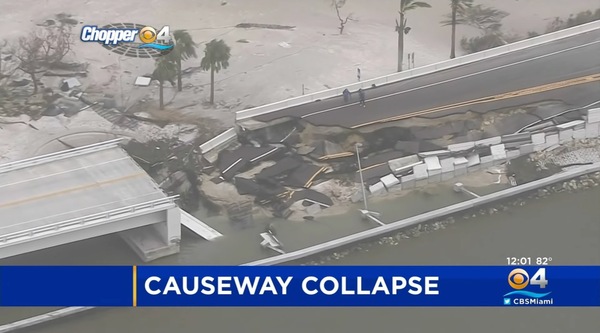
–>
October 18, 2022
I live in Florida, home to numerous hurricane hits. I was without grid power for eight days when Hurricane Charlie came within a mile of my house in 2004. Later on, Frances and Jeanne were nearly as impressive, and I live in Central Florida, over a hundred miles from the coast where they came ashore. When Hurricane Ian hit, we were prepared. Our permanently installed generator kicked on fifteen seconds after Duke Energy went down, and ran beautifully for five days. If only Spectrum could have gotten their internet service up that fast…
‘); googletag.cmd.push(function () { googletag.display(‘div-gpt-ad-1609268089992-0’); }); }
One of my friends lived in Fort Myers, and he didn’t fare quite so well. The weather forecasters thought Ian would strike Tampa, then the panhandle, then Tampa, and at the last minute Fort Myers. He rode out the storm surge on a plastic-wrapped mattress in his living room where the water had been about four feet deep. His house and cars were totaled, and they were about twenty miles inland from the Gulf of Mexico, but only five hundred feet from the Caloosahatchee River. He’s actually in pretty good shape compared to residents of Sanibel Island, where some structures may still stand, but the damage is nearly total. The causeway and bridge connecting the barrier island to the mainland were destroyed.
All of this raises a simple question. What is the best way to deal with this sort of natural disaster? Where I live, it’s an inconvenience from which I can easily recover. That’s a lot like Tornado Alley where some people die each year, but most are unaffected. And even though California gets a lot of earthquakes, most people aren’t seriously affected and, contrary to Red State fever dreams, California won’t slide into the Pacific Ocean with the next temblor, thus favorably altering the political balance of the country. In short, there are natural challenges everywhere. But a few places are more challenged than others.

Image: Collapsed Fort Myers causeway. YouTube screen grab.
Barrier islands protect the Atlantic and Gulf coasts all the way from New York (Long Island!) to the Mexican border. They are mostly low sand bars that change shape from year to year as storms move the sand around. These islands also protect vast wetlands that are a key foundation of the food chain. In areas where the mainland is more solid, the barrier islands generally prevent the worst of storm damage.
‘); googletag.cmd.push(function () { googletag.display(‘div-gpt-ad-1609270365559-0’); }); }
Present-day barrier islands are great playgrounds in good weather. After storms, some, like Sanibel, are wonderful for beachcombing. But they are, by their very nature, awful places to build houses. They are equally rotten hotel locations, but the attraction of the island rubs off on every form of habitation.
If every property owner had to purchase flood/hurricane insurance on an open market, it’s likely a lot would not be able to come up with the scratch. It would be just too rich for their blood. But in 1968, the Feds decided that it would be good to “help” out coastal communities. They would have to do some land use planning, but ultimately, the lure of higher local tax bases won out. Over time, subsidized rates became the norm as President Obama finalized them in 2014.
Subsidized flood insurance means that sensitive barrier island ecologies are disrupted by massive cancers of concrete, steel, and lumber. When a storm at sea leads to high waves and beach erosion, the State of Florida dumps millions of dollars harvested from inland on those beaches in the form of megatons of sand. “Someone’s home is about to be washed out to sea!”
Now bring that storm ashore, and remember that this is what nature does. It refreshes and remodels the shore by bringing deep ocean water up over the low-lying barrier islands. Sanibel was completely overtopped. Fort Myers Beach was inundated. Only rare structures escaped catastrophic damage for twenty miles inland because that entire area was no more than about five feet above sea level. And had the storm come ashore as predicted at Tampa Bay, the storm surge would have caused nearly a trillion dollars of damage. That’s not a misprint. “Trillion.” With a “T.”
It’s one thing to insure against occasional risks, such as auto accidents. They are predictable in a statistical sense. Young boys are more likely to drive poorly than older adults, so they have higher premiums. But when you live on the seashore where massive storms are frequent visitors, a proper insurance premium would make that lifestyle choice too expensive for the average person. Barack Obama may be able to insure his Martha’s Vineyard mansion against Nor’ Easters, but Joe Sixpack can’t afford the real cost to cover a thousand-square-foot cottage a mile from the shore. That risk takes more than he can earn.
But when the Federal Government takes money from New Mexico and Illinois to subsidize Fort Myers, a lot of people flock to the beach. Their homes destroy wetlands and shorebird habitat. That alone should get the Sierra Club and Greenpeace exercised. But the outcry seems to be “Rebuild!” not “reconsider.” We have to review the moral hazard subsidized flood insurance creates. And by the way, protecting those wealthy enough to live next to the sand isn’t an enumerated power of the Federal government listed in Article I, Section 8, even if we read “general welfare” expansively.
‘); googletag.cmd.push(function () { googletag.display(‘div-gpt-ad-1609268078422-0’); }); } if (publir_show_ads) { document.write(“
We must get the government out of the flood insurance business. Stopping it overnight is probably a bad idea because current owners have a legal “reliance interest” in the program. So a stepwise approach must be found. The simplest approach might be called the “Hurricane Ian” solution. Every building wiped out by the storm would fall under this proposal.
If you lost your home or business due to the storm and were covered by Federal flood insurance, the Feds should pay you the full pre-storm value of the property, including the dirt. Then, the Feds would turn the property over to the state for full demolition and return to nature with a deed restriction that prevents construction on the site. Obviously, there would be an exception for basic park facilities such as parking lots and restrooms, but residences of any sort would be completely forbidden. In a subsequent storm, those would be relatively inexpensive and easy to rebuild.
In our current example, Sanibel Island would become a State Park nature preserve instead of a high-end residential community. The high rise resorts would go away, either because room rents were too high for most or because storm damage was severe. Much of Fort Myers Beach would undergo the same treatment. But neither area would be eligible for building.
I can hear the cries from the cheap seats. “No! You can’t do that to us!” Actually, we can. And in doing it, you will be made whole. By giving you the entire pre-storm value of your property, you’ve effectively sold at a tidy profit. That will give you enough money to move. You just can’t rebuild on sensitive lands.
This ought to be strongly supported by Green groups because the process would restore lots of land to nature. The handful of properties not covered by Federal flood insurance would become prized land for development by the upper crust, but would not be eligible for subsidized insurance. They’d bear all their own burden. Taxpayers in North Dakota would be off the hook.
The only losers in this approach would be the people who simply “can’t” give up their beach lifestyle and the municipalities that would see their tax base shrink. I’ll shed a few crocodile tears for them.
Ted Noel MD is a retired Anesthesiologist/Intensivist who podcasts and posts on social media as DoctorTed and @vidzette. His DoctorTed podcasts are available on many podcast channels.
<!– if(page_width_onload <= 479) { document.write("
“); googletag.cmd.push(function() { googletag.display(‘div-gpt-ad-1345489840937-4’); }); } –> If you experience technical problems, please write to [email protected]
FOLLOW US ON
<!–
–>
<!– _qoptions={ qacct:”p-9bKF-NgTuSFM6″ }; ![]() –> <!—-> <!– var addthis_share = { email_template: “new_template” } –>
–> <!—-> <!– var addthis_share = { email_template: “new_template” } –>





